跨文化沟通(cross-culture communication)
- 格式:ppt
- 大小:3.61 MB
- 文档页数:21
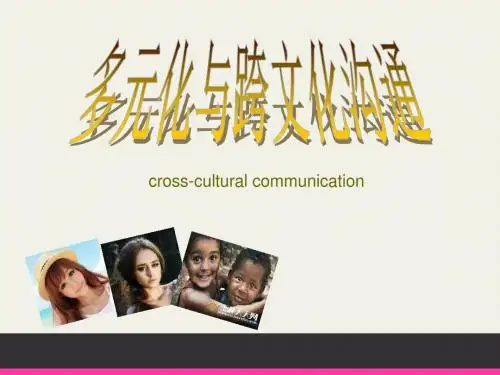
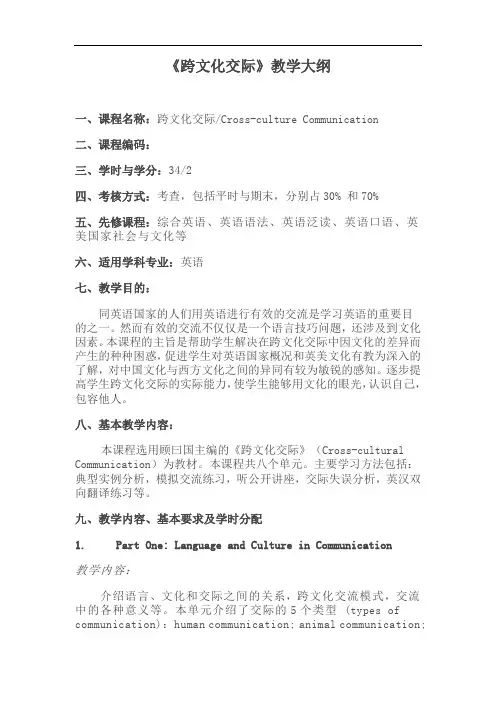
《跨文化交际》教学大纲一、课程名称:跨文化交际/Cross-culture Communication二、课程编码:三、学时与学分:34/2四、考核方式:考查,包括平时与期末,分别占30% 和70%五、先修课程:综合英语、英语语法、英语泛读、英语口语、英美国家社会与文化等六、适用学科专业:英语七、教学目的:同英语国家的人们用英语进行有效的交流是学习英语的重要目的之一。
然而有效的交流不仅仅是一个语言技巧问题,还涉及到文化因素。
本课程的主旨是帮助学生解决在跨文化交际中因文化的差异而产生的种种困惑,促进学生对英语国家概况和英美文化有教为深入的了解,对中国文化与西方文化之间的异同有较为敏锐的感知。
逐步提高学生跨文化交际的实际能力,使学生能够用文化的眼光,认识自己,包容他人。
八、基本教学内容:本课程选用顾曰国主编的《跨文化交际》(Cross-cultural Communication)为教材。
本课程共八个单元。
主要学习方法包括:典型实例分析,模拟交流练习,听公开讲座,交际失误分析,英汉双向翻译练习等。
九、教学内容、基本要求及学时分配1. Part One: Language and Culture in Communication教学内容:介绍语言、文化和交际之间的关系,跨文化交流模式,交流中的各种意义等。
本单元介绍了交际的5个类型 (types of communication):human communication; animal communication;human-animal communication; human-machine communication; machine-to-machine communication;交际的基本模式:同文化交际(mono-cultural language communication);跨文化交际(cross-cultural language communication);介绍各种交际方式中的“意思”的传达。
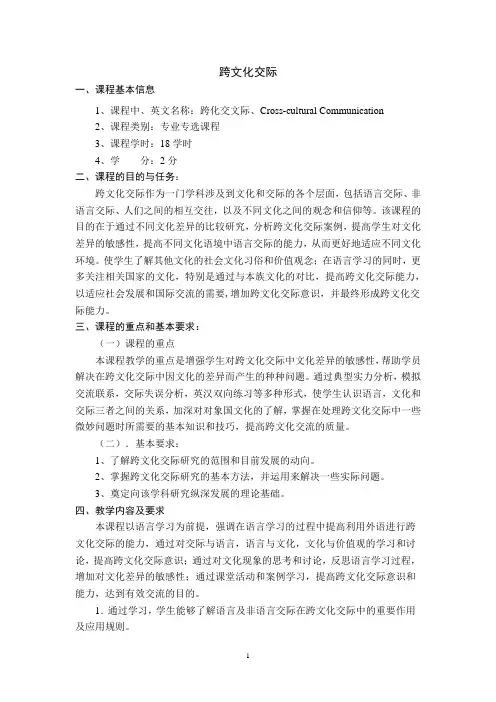
跨文化交际一、课程基本信息1、课程中、英文名称:跨化交文际、Cross-cultural Communication2、课程类别:专业专选课程3、课程学时:18学时4、学分:2分二、课程的目的与任务:跨文化交际作为一门学科涉及到文化和交际的各个层面,包括语言交际、非语言交际、人们之间的相互交往,以及不同文化之间的观念和信仰等。
该课程的目的在于通过不同文化差异的比较研究,分析跨文化交际案例,提高学生对文化差异的敏感性,提高不同文化语境中语言交际的能力,从而更好地适应不同文化环境。
使学生了解其他文化的社会文化习俗和价值观念;在语言学习的同时,更多关注相关国家的文化,特别是通过与本族文化的对比,提高跨文化交际能力,以适应社会发展和国际交流的需要,增加跨文化交际意识,并最终形成跨文化交际能力。
三、课程的重点和基本要求:(一)课程的重点本课程教学的重点是增强学生对跨文化交际中文化差异的敏感性,帮助学员解决在跨文化交际中因文化的差异而产生的种种问题。
通过典型实力分析,模拟交流联系,交际失误分析,英汉双向练习等多种形式,使学生认识语言,文化和交际三者之间的关系,加深对对象国文化的了解,掌握在处理跨文化交际中一些微妙问题时所需要的基本知识和技巧,提高跨文化交流的质量。
(二).基本要求:1、了解跨文化交际研究的范围和目前发展的动向。
2、掌握跨文化交际研究的基本方法,并运用来解决一些实际问题。
3、奠定向该学科研究纵深发展的理论基础。
四、教学内容及要求本课程以语言学习为前提,强调在语言学习的过程中提高利用外语进行跨文化交际的能力,通过对交际与语言,语言与文化,文化与价值观的学习和讨论,提高跨文化交际意识;通过对文化现象的思考和讨论,反思语言学习过程,增加对文化差异的敏感性;通过课堂活动和案例学习,提高跨文化交际意识和能力,达到有效交流的目的。
1.通过学习,学生能够了解语言及非语言交际在跨文化交际中的重要作用及应用规则。
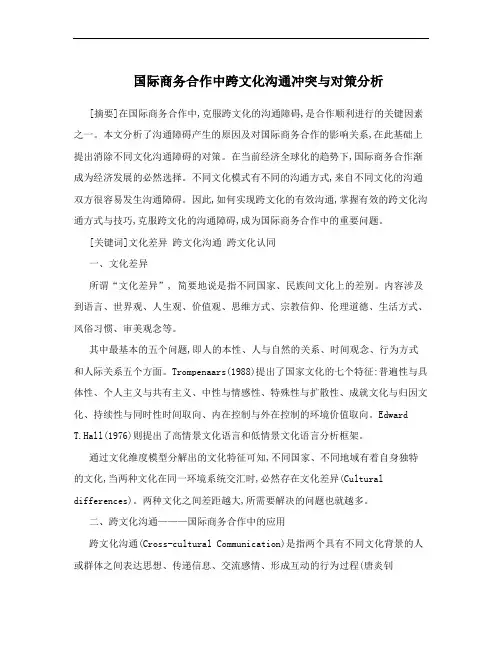
国际商务合作中跨文化沟通冲突与对策分析[摘要]在国际商务合作中,克服跨文化的沟通障碍,是合作顺利进行的关键因素之一。
本文分析了沟通障碍产生的原因及对国际商务合作的影响关系,在此基础上提出消除不同文化沟通障碍的对策。
在当前经济全球化的趋势下,国际商务合作渐成为经济发展的必然选择。
不同文化模式有不同的沟通方式,来自不同文化的沟通双方很容易发生沟通障碍。
因此,如何实现跨文化的有效沟通,掌握有效的跨文化沟通方式与技巧,克服跨文化的沟通障碍,成为国际商务合作中的重要问题。
[关键词]文化差异跨文化沟通跨文化认同一、文化差异所谓“文化差异”, 简要地说是指不同国家、民族间文化上的差别。
内容涉及到语言、世界观、人生观、价值观、思维方式、宗教信仰、伦理道德、生活方式、风俗习惯、审美观念等。
其中最基本的五个问题,即人的本性、人与自然的关系、时间观念、行为方式和人际关系五个方面。
Trompenaars(1988)提出了国家文化的七个特征:普遍性与具体性、个人主义与共有主义、中性与情感性、特殊性与扩散性、成就文化与归因文化、持续性与同时性时间取向、内在控制与外在控制的环境价值取向。
Edward T.Hall(1976)则提出了高情景文化语言和低情景文化语言分析框架。
通过文化维度模型分解出的文化特征可知,不同国家、不同地域有着自身独特的文化,当两种文化在同一环境系统交汇时,必然存在文化差异(Cultural differences)。
两种文化之间差距越大,所需要解决的问题也就越多。
二、跨文化沟通———国际商务合作中的应用跨文化沟通(Cross-cultural Communication)是指两个具有不同文化背景的人或群体之间表达思想、传递信息、交流感情、形成互动的行为过程(唐炎钊等,2005)。
陈剑平等(2005)提出跨文化沟通的实质,是不同文化双方对彼此尊重和理解。
从广义而言,跨文化沟通的目的在于存在文化差异的双方在尽量避免或者减少跨文化风险(Cross-cultural Risks)的前提下,求同存异,积极发展双方的文化认同感(Cultural Identity),将跨文化(Cross-cultural Conflict)降低到最低程度,产生文化协同效应(Cultural Synergy)。

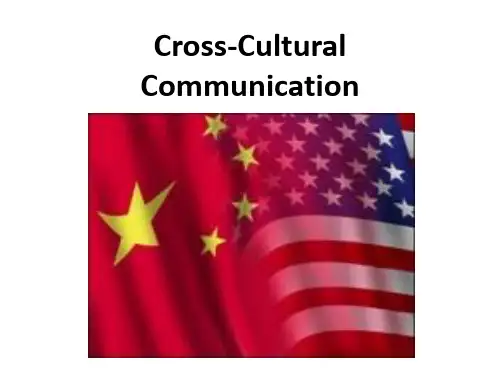
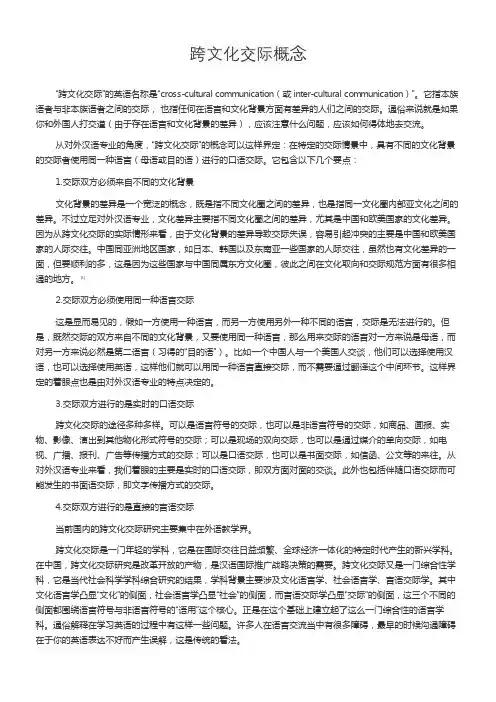
跨文化交际概念“跨文化交际”的英语名称是“cross-cultural communication(或inter-cultural communication)”。
它指本族语者与非本族语者之间的交际,也指任何在语言和文化背景方面有差异的人们之间的交际。
通俗来说就是如果你和外国人打交道(由于存在语言和文化背景的差异),应该注意什么问题,应该如何得体地去交流。
从对外汉语专业的角度,“跨文化交际”的概念可以这样界定:在特定的交际情景中,具有不同的文化背景的交际者使用同一种语言(母语或目的语)进行的口语交际。
它包含以下几个要点:1.交际双方必须来自不同的文化背景文化背景的差异是一个宽泛的概念,既是指不同文化圈之间的差异,也是指同一文化圈内部亚文化之间的差异。
不过立足对外汉语专业,文化差异主要指不同文化圈之间的差异,尤其是中国和欧美国家的文化差异。
因为从跨文化交际的实际情形来看,由于文化背景的差异导致交际失误,容易引起冲突的主要是中国和欧美国家的人际交往。
中国同亚洲地区国家,如日本、韩国以及东南亚一些国家的人际交往,虽然也有文化差异的一面,但要顺利的多,这是因为这些国家与中国同属东方文化圈,彼此之间在文化取向和交际规范方面有很多相通的地方。
[1]2.交际双方必须使用同一种语言交际这是显而易见的,假如一方使用一种语言,而另一方使用另外一种不同的语言,交际是无法进行的。
但是,既然交际的双方来自不同的文化背景,又要使用同一种语言,那么用来交际的语言对一方来说是母语,而对另一方来说必然是第二语言(习得的“目的语”)。
比如一个中国人与一个美国人交谈,他们可以选择使用汉语,也可以选择使用英语,这样他们就可以用同一种语言直接交际,而不需要通过翻译这个中间环节。
这样界定的着眼点也是由对外汉语专业的特点决定的。
3.交际双方进行的是实时的口语交际跨文化交际的途径多种多样。
可以是语言符号的交际,也可以是非语言符号的交际,如商品、画报、实物、影像、演出到其他物化形式符号的交际;可以是现场的双向交际,也可以是通过媒介的单向交际,如电视、广播、报刊、广告等传播方式的交际;可以是口语交际,也可以是书面交际,如信函、公文等的来往。
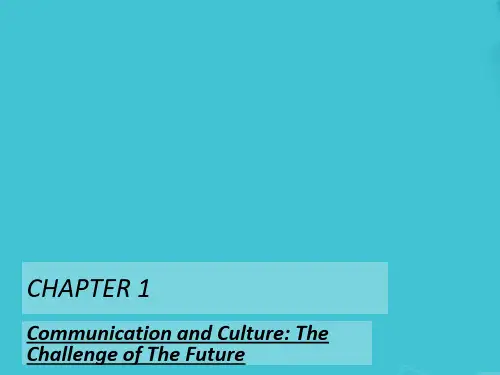
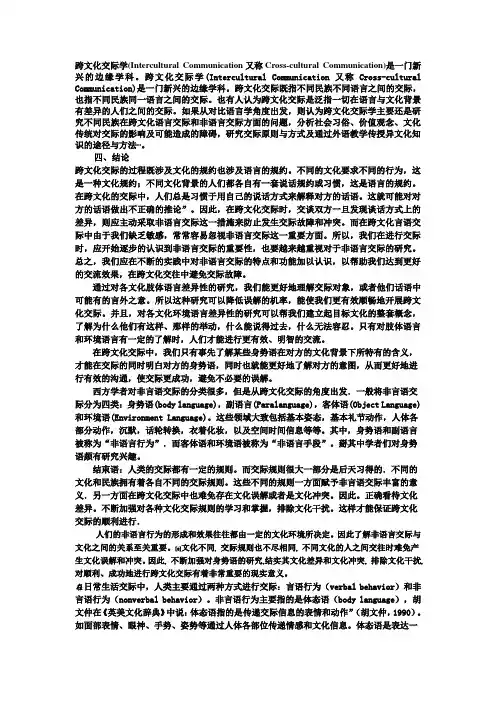
跨文化交际学(Intercultural Communication又称Cross-cultural Communication)是一门新兴的边缘学科。
跨文化交际学(Intercultural Communication又称Cross-cultural Communication)是一门新兴的边缘学科。
跨文化交际既指不同民族不同语言之间的交际,也指不同民族同一语言之间的交际。
也有人认为跨文化交际是泛指一切在语言与文化背景有差异的人们之间的交际。
如果从对比语言学角度出发,则认为跨文化交际学主要还是研究不同民族在跨文化语言交际和非语言交际方面的问题,分析社会习俗、价值观念、文化传统对交际的影响及可能造成的障碍,研究交际原则与方式及通过外语教学传授异文化知识的途径与方法⋯。
四、结论跨文化交际的过程既涉及文化的规约也涉及语言的规约。
不同的文化要求不同的行为,这是一种文化规约;不同文化背景的人们都各自有一套说话规约或习惯,这是语言的规约。
在跨文化的交际中,人们总是习惯于用自己的说话方式来解释对方的话语。
这就可能对对方的话语做出不正确的推论”。
因此,在跨文化交际时,交谈双方一旦发现谈话方式上的差异,则应主动采取非语言交际这一措施来防止发生交际故障和冲突。
而在跨文化言语交际中由于我们缺乏敏感,常常容易忽视非语言交际这一重要方面。
所以,我们在进行交际时,应开始逐步的认识到非语言交际的重要性,也要越来越重视对于非语言交际的研究。
总之,我们应在不断的实践中对非语言交际的特点和功能加以认识,以帮助我们达到更好的交流效果,在跨文化交往中避免交际故障。
通过对各文化肢体语言差异性的研究,我们能更好地理解交际对象,或者他们话语中可能有的言外之意。
所以这种研究可以降低误解的机率,能使我们更有效顺畅地开展跨文化交际。
并且,对各文化环境语言差异性的研究可以帮我们建立起目标文化的整套概念,了解为什么他们有这样、那样的举动,什么能说得过去,什么无法容忍。
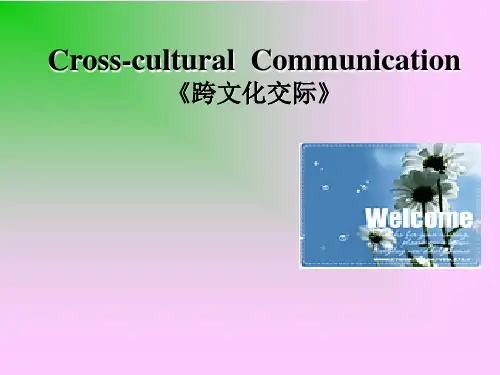
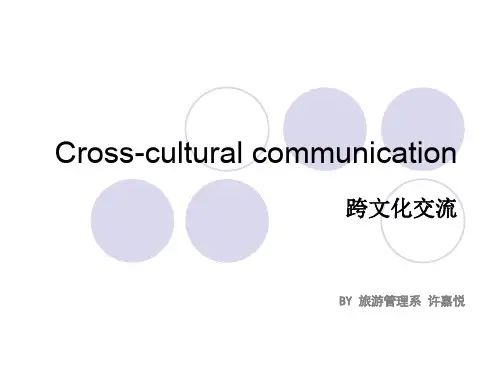
跨文化沟通(Cross-Cultural Communication),通常是指不同文化背景的人之间发生的沟通行为。
因为地域不同、种族不同等因素导致文化差异,因此,跨文化沟通可能发生在国际间,也能发生在不同的文化群体之间。
措施:1.培养跨文化意识。
具体来说就是导入要进行跨文化沟通对象的文化要素,树立文化差异的意识。
在有了这个意识的基础上,要主动地学习对方的语言、句式、文化,联系听说能力,以便更好地与对方进行沟通。
有了语言的基础后,就可以有针对性地比较沟通对象的文化与自己母文化的差异,提高对异文化差异的察觉。
2.在有条件的情况下可以,通过模拟真实情景(通常可以与熟悉目标文化的人员进行拍档),加强语言实践,强化文化差异性的适应能力。
3.正确对待文化差异,这其中包含了两个认知的层次。
第一个层次是正确地意识承认有文化差异的存在。
第二个层次是正确地对待文化的差异,积极的学习、适应、包容它。
这一个过程要注意保持不卑不亢的态度。
既不能有霸权文化意识,也不可以有自卑意识。
文化与国家或者地区的强弱并没有必要的联系。
4.熟悉掌握沟通的技巧。
在语言沟通中,要注意口语交流和书面沟通的不同层面的不同作用。
在与对方进行语言沟通的时候,要给足够停顿的时间给对方和自己进行语言交换。
此外还有注意在沟通时,不能先假设对方已经理解,反而应该先假设对方不能理解你的意思,通过不断的检查来估计对方对你的话语的理解能力。
5.培养非语言的沟通技巧。
在进行跨文化共同的时候应该要留意对方的身体语言。
我们可以借助观察对方的手势,面部表情等身体语言来了解他的意图;另外我们也要熟悉地使用身体语言,一方面可以运用身体语言更好地表达我们的意思弥补语言沟通的障碍,另一方面可以避免有歧义的身体语言的出现造成不必要的误会,例如手势。
由于各国的文化存在着多样性的特点,无论是表层的语言、礼仪,还是中层次的建筑、饮食、礼仪或者处于核心层次的民族价值观、思维等等。
这就决定我们在进行跨文化沟通的时候会遇到障碍和冲突,如何能有效地跨文化沟通具有十分重要的意义。
跨文化沟通的意义一、概述跨文化沟通(Cross-Cultural Communication),通常是指不同文化背景的人之间发生的沟通行为。
因为地域不同、种族不同等因素导致文化差异,因此,跨文化沟通可能发生在国际间,也能发生在不同的文化群体之间。
观察一个文化的角度:交流与语言、自我意识与空间、衣着与打扮、食品与饮食习惯、时间与时间意识、季节观念、各种人际关系、价值观与规范、信仰与态度、思维过程与学习、工作习惯与实践等。
理解一个文化系统,可以考察研究的系统:亲属系统、教育系统、经济系统、政治系统、宗教系统、协会系统、卫生保健系统,娱乐系统等。
所谓跨文化沟通,是在这样一种情况下发生的:即信息的发出者是一种文化的成员,而接受者是另一种文化的成员。
二、跨文化沟通的研究内容跨文化沟通研究主要有三个内容:其一是沟通;其二是文化及其对沟通的影响;其三是跨文化沟通中的问题及解决方法。
1.沟通:沟通是复杂的过程,给出它的唯一定义是困难的。
对沟通的定义基本上可分为两派,一派将沟通描述为一个人有意地将信息传递给另一个人的过程;另一派定义为某一个体发出刺激物以调整其他个体的行为的过程。
这两种意义都假定发出信息者是有意的。
另有人认为,即使发出信息者是无意识的,信息也可能影响对方,从而构成沟通。
所谓“说者无心,听者有意”。
所以,就将沟通定义为人们相互影响的所有过程。
还有一种是从心理学角度定义沟通,认为沟通是与一切有意义的情境相关的过程。
萨姆瓦等人对沟通的定义是:一种双边的、影响行为的过程;在这一过程中,一方(信息源)有意向地将信息编码并通过一定渠道传递给意向所指的另一方(接受者),以期唤起特定的反应或行为。
完整的沟通过程包括:意向所指的信息接受者感受到信息的传递,赋予信息以意义,并受其影响做出反应。
2.文化及其对沟通的影响:文化是复杂的人类生活现象,关于文化的定义,更是宠杂多样,据说有数百种。
对于文化,大致可以这样来把握:人类的非本能的生活和行为方式都可以称为文化。
商务跨文化交际“跨文化传播”的概念:什么是跨文化传播学呢?跨文化传播学是由美国人类学家、跨文化研究学者爱德华•霍尔在20世纪50年代建立的一门学科,其英文表达为“Intercultural Communication 或Cross-cultural Communication”,在我国也翻译为“跨文化交际学”或者“跨文化交流学”。
跨文化传播学作为传播学的一个分支学科,旨在研究来自不同文化背景的人们是如何进行交流以及研究如何提高跨文化交流技巧,跨越跨文化交流障碍的方法和途径。
跨文化传播学是一门跨领域的学科,融合了人类学、文化学、心理学以及传播学等领域的研究成果。
跨文化传播的主要理论见诸于有关文化差异(文化维度)的著作中,特别是吉尔特•••••霍夫斯泰德(Geert Hofstede)、哈里• C. 特兰狄斯(Harry C. Triandis)、方斯•特龙皮纳尔斯(Fons Trompenaars)、沙龙•施瓦兹(ShalomSchwartz)及克里佛德•吉尔兹(Clifford Geertz)等人的著作中。
目前,这些学者的相关理论已经广泛地运用到传播理论和传播情景中,特别是商务、管理和市场营销之中。
爱德华•霍尔(1914年5月16日出生于美国的密苏里州),社会学/文化人类学博士后。
20世纪50年代,爱德华•霍尔在美国美国政府部门的外派人员培训学院(Foreign Service Institute)任教,对外派出国人员进行跨文化技能培训。
期间,他提出了“高语境”和“低语境”文化,并撰写了几部非常畅销的有关跨文化传播的著作。
目录1,General Introduction…,2, What Does Cross-Cultural Communication Mean to Business People 3,How to Make Introduction4,How to Deal with Business Cards5,How to Schedule Visiting and Entertaining6,ABC for Gifts Exchanging ,7, Are There Any Differences in Male and Female’s Communication8,How Are Roles Females Playing in International Business?9, What Is the Range of Non-Verbal Communication in Business? … 10,Similar Encoding and Decoding of Non-Verbal Signals11,What Is Culture Conflict?12,What Is Culture Shock,and Acculturation13,What Is It Like at Negotiation Table14,The Device of Stereotyping in Cross—Cultural Communication 15,How Can We Be InternationalHofstede and his Five Cultural Dimensions"Culture is more often a source of conflict than of synergy. Cultural differences are a nuisance at best and often a disaster." Prof. Geert Hofsted霍夫斯泰德, Emeritus Professor, Maastricht University. Increasing internationalization has led to an appreciation that cultural differences are a key factor in getting things done in business. Working in France, Japan or the USA, for example, requires totally different styles of managing and co-operating.Professor Geert Hofstede has developed a five-dimensional model which explains cultural differences in a unique and powerful manner.Description for each of Hofstede's Dimensions1.Power Distance权利距离Index (PDI) that is the extent to which the less powerful members of organizations and institutions (like the family) accept and expect that power is distributed unequally. This represents inequality (more versus less), but defined from below, not from above. It suggests that a society's level of inequality is endorsed by the followers as much as by the leaders. Power and inequality, of course, are extremely fundamental facts of any society and anybody with some international experience will be aware that 'all societies are unequal, but some are more unequal than others'.2. Individualism (IDV) on the one side versus its opposite, collectivism, that is the degree to which individuals are integrated into groups. On the individualist side we find societies in which the ties between individuals are loose: everyone is expected to look after him/herself and his/her immediate family. On the collectivist side, we find societies in which people from birth onwards are integrated into strong, cohesive in-groups, often extended families (with uncles, aunts and grandparents) which continue protecting them in exchange for unquestioning loyalty. The word 'collectivism' in this sense has no political meaning: it refers to the group, not to the state. Again, the issue addressed by this dimension is an extremely fundamental one, regarding all societies in the world.3. Masculinity (MAS) versus its opposite, femininity, refers to the distribution of roles between the genders which is another fundamental issue for any society to which a range of solutions are found. The IBM studies revealed that (a) women's values differ less among societies than men's values; (b) men's values from one country to another contain a dimension from very assertive and competitive and maximally different from women's values on the one side, to modest and caring and similar to women's values on the other. The assertive pole has been called 'masculine' and the modest, caring pole 'feminine'. The women in feminine countries have the same modest, caring values as the men; in the masculine countries they are somewhat assertive and competitive, but not as much as the men, so that these countries show a gap between men's values and women's values.4. Uncertainty Avoidance不确定性规避指数Index (UAI) deals with a society's tolerance for uncertainty and ambiguity; it ultimately refers to man's search for Truth. It indicates to what extent a culture programs its members to feel either uncomfortable or comfortable in unstructured situations. Unstructured situations are novel, unknown, surprising, different from usual. Uncertainty avoiding cultures try to minimize the possibility of such situations by strict laws and rules, safety and security measures, and on the philosophical and religious level by a belief in absolute Truth; 'there can only be one Truth and we have it'. People in uncertainty avoiding countries are also more emotional, and motivated by inner nervous energy. The opposite type, uncertainty accepting cultures, are more tolerant of opinions different from what they are used to; they try to have as few rules as possible, and on the philosophical and religious level they are relativist and allow many currents to flow side by side. People within these cultures are more phlegmatic and contemplative, and not expected by their environment to express emotions.5. Long-Term Orientation (LTO) versus short-term orientation:长期观和短期观this fifth dimension was found in a study among students in 23 countries around the world, using a questionnaire designed by Chinese scholars. It can be said to deal with Virtue regardless of Truth与真理无关,与传统美德有关. Values associated with Long Term Orientation are thrift节俭,坚忍不拔(中国人)and perseverance and protecting one's 'face'; values associated with Short Term Orientation are respect for tradition, fulfilling social obligations,. Both the positively and the negatively rated values of this dimension are found in the teachings of Confucius, the most influential Chinese philosopher who lived around 500 B.C.; however, the dimension also applies to countries without a Confucian heritage.CHINAGeert Hofstede analysis for China has Long-term Orientation (LTO) thehighest-ranking factor (118), which is true for all Asian cultures. This Dimension indicates a society's time perspective and an attitude of persevering; that is,overcoming obstacles with time, if not with will and strength. (see Asian countries graph below)The Chinese rank lower than any other Asian country in the Individualism (IDV) ranking, at 20 compared to an average of 24. This may be attributed, in part, to the high level of emphasis on a Collectivist society by the Communist rule, as compared to one of Individualism.The low Individualism ranking is manifest in a close and committed member 'group', be that a family, extended family, or extended relationships. Loyalty in a collectivist culture is paramount. The society fosters strong relationships where everyone takes responsibility for fellow members of their group.U.S.AThere are only seven (7) countries in the Geert Hofstede research that have Individualism (IDV) as their highest Dimension: USA (91), Australia (90), United Kingdom (89), Netherlands and Canada (80), and Italy (76).The high Individualism (IDV) ranking for the United States indicates a society with a more individualistic attitude and relatively loose bonds with others. The populace is more self-reliant and looks out for themselves and their close family members.The next highest Hofstede Dimension is Masculinity (MAS) with a ranking of 62, compared with a world average of 50. This indicates the country experiences a higher degree of gender differentiation of roles. The male dominates a significant portion of the society and power structure. This situation generates a female population that becomes more assertive and competitive, with women shifting toward the male role model and away from their female role.The United States was included in the group of countries that had the Long Term Orientation (LTO) Dimension added. The LTO is the lowest Dimension for the US at 29, compared to the world average of 45. This low LTO ranking is indicative of the societies' belief in meeting its obligations and tends to reflect an appreciation for cultural traditions.The next lowest ranking Dimension for the United States is Power Distance (PDI) at 40, compared to the world Average of 55. This is indicative of a greater equality between societal levels, including government, organizations, and even within families. This orientation reinforces a cooperative interaction across power levels and creates a more stable cultural environment.IntrinsicThe last Geert Hofstede Dimension for the US is Uncertainty Avoidance (UAI), with a ranking of 46, compared to the world average of 64. A low ranking in theUncertainty Avoidance Dimension is indicative of a society that has fewer rules and does not attempt to control all outcomes and results. It also has a greater level of tolerance for a variety of ideas, thoughts, and beliefs."high context" and "low context"The general terms "high context" and "low context" (popularized by Edward Hall) are used to describe broad-brush cultural differences between societies.High context refers to societies or groups where people have close connections over a long period of time. Many aspects of cultural behavior are not made explicit because most members know what to do and what to think from years of interaction with each other. Your family is probably an example of a high context environment.Low context refers to societies where people tend to have many connections but of shorter duration or for some specific reason. In these societies, cultural behavior and beliefs may need to be spelled out explicitly so that those coming into the cultural environment know how to behave.Monochronic Time VS Polychronic TimeMonochronic TimeA monochronic time system means that things are done one at a time and time is segmented into precise, small units. Under this system time is scheduled, arranged and managed.The United States is considered a monochronic society. This perception of time is learned and rooted in the Industrial Revolution, where "factory life required the labor force to be on hand and in place at an appointed hour". For Americans, time is a precious resource not to be wasted or taken lightly. "We buy time, save time,spend time and make time. Our time can be broken down into years, months, days, hours, minutes, seconds and even milliseconds. We use time to structure both our daily lives and events that we are planning for the future. We have schedules that we must follow: appointments that we must go to at a certain time, classes that start and end at certain times, work schedules that start and end at certain times, and even our favorite TV shows, that start and end at a certain time.”Monochronic Cultures* United States* Canada* Switzerland* Germany* ScandinaviaPolychronic TimeA polychronic time system is a system where several things can be done at once, and a more fluid approach is taken to scheduling time. Unlike Americans and most northern and western European cultures, Latin American and Arabic cultures use the polychronic system of time.These cultures are much less focused on the preciseness of accounting for each and every moment. As Raymond Cohen notes polychronic cultures are deeply steeped in tradition rather than in tasks -- a clear difference from their monochronic counterparts. Cohen notes that "Traditional societies have all the time in the world. The arbitrary divisions of the clock face have little saliency in cultures grounded in the cycle of the seasons, the invariant pattern of rural life, and the calendar of religious festivities".Instead, their culture is more focused on relationships, rather than watching the clock. They have no problem being “late” for an event if they are with family or friends, because the relationship is what really matters. As a result, polychronic cultures have a much less formal perception of time. They are not ruled by precise calendars and schedules. Rather, “cultures that use the polychronic time system often schedule multiple appointments simultaneously so keeping on schedule is an impossibility.Polychronic Cultures* Saudi Arabia * Egypt * Mexico * Philippines Monochronic People Polychronic Peopledo one thing at a time do many things at onceconcentrate on the job are highly distractible and subject tointerruptionstake time commitments (deadlines, schedules) seriously consider an objective to be achieved,if possibleare low-context and need information are high-context and already haveinformationcommitted to the job are committed to people and humanrelationshipsadhere religiously to plans change plans often and easilyare concerned about not disturbing others; follow rules of privacy and consideration are more concerned with those who are closely related than with privacyshow great respect for private property; borrow and lend things often andseldom borrow or lend easilyemphasize promptness base promptness on the relationshipare accustomed to short-termrelationships have strong tendency to build lifetimerelationshipsGENDRE ROLESGender is a set of characteristics distinguishing between male and female, particularly in the cases of men and women. Depending on the context, the discriminating characteristics vary from sex to social role to gender identity.StereotypesGeneralization of all national cultures. Use this kind of summary to have apre-impression of your customers. But never take any prejudice.Stereotypes make more sense when you consider the cultural roots of the group being stereotyped. For example:NATIONALITY: GERMANSTEROTYPE: The Germans are usually seen as rigid, somewhat humorless and obsessed with order formality. A smile does not come easily and business is taken seriously. They are particularly focused on detail.NATIONAL CULTURAL TRAITS: Low-contest culture that values precise communication. Focuses on what is being said rather than who is saying it. Monochronic, that is, they are a very linear concept of time and prefer to do one thing at a time. The German culture is one of very high risk-avoidance.NATIONALITY: AMERICANSTEROTYPE: Brash, materialistic. A cowboy culture where individuals are obsessed with time and deadlines. A society played by crime and violence. NATIONAL CULTURAL TRAITS: American culture is task-driven and places great value on individual achievement and thinking. Monochronic, with a very low risk-avoidance, which allows American to speak without thinking and often act without thinking, sometimes in a violent manner. It is a very masculine culture, which means that society appreciates assertiveness while respecting the goal or material acquisition.NATIONALITY: JAPANESESTEROTYPE: Very group-oriented, quiet, shy, reserved and highly respectful of status and position. Negotiate in groups or teams and avoid criticism of partners or proposals. Japanese will work their whole career at a singly company.NATIONAL CULTURAL TRAITS: The Japanese culture is collectivist by nature, that is, group achievement and harmony comes before that of individual fulfillment. It is a high power-distance culture where workers do not seek personal decision-making powers. It is high risk-avoidance.NATIONALITY: FRENCHSTEROTYPE : Romantic, fond of good food, food art, and not overly concerned about doing great business, more eager to argue politics and art than to do business.NATIONAL CULTURAL TRAITS: A highly feminine culture which values interpersonal relationships,putting quality of life before material acquisition and applauds concern for other individuals. Also high-context, which mean that themedium is the message and not overly concerned about precise detail or communication.NATIONALITY: ITALIANSTEROTYPE:Excitable and seem to relish chaos,. Not very detail-oriented when it comes to business, which seems to take forever conclude. They are romantic and seem to shake hands with and kiss visitors forever, very demonstrative and physical.NATIONAL CULTURAL TRAITS:Italians are poly-chronic which means they prefer to do several takes at one time in no particular order. Their concept of time is nonlinear. It is also a high-context, relationship-driven culture.NATIONALITY: BRITISHSTEROTYPE:Stuffy, prim and proper, Business if done through on "old boy's network".NATIONAL CULTURAL TRAITS: Low-context, low risk-avoidance, monochromic, mixture of relationship-driven and task-driven cultures.NATIONALITY: CHINESESTEROTYPE:Like the Japanese, they always seem to travel in groups. They are quite, reserved and never lose their temper. But at times they can seem chaotic and unfocused.NATIONAL CULTURAL TRAITS:The Buddhist philosophy plays an important role in business dealings and the approach to life. It is a collectivist, high-context, poly-choronic culture.NATIONALITY: NIGERIANSTEROTYPE:Gregarious, outgoing and eager to please. Seem never to say "no" and enjoy physical contact but are never on time for anything. Great schemers. NATIONAL CULTURAL TRAITS:A poly-chronic, high-context,relationship driven society.NATIONALITY: ISRAELISTEROTYPE:The Israelis are brash and rude wheeler-dealers who always seem to have something to say about just about everything.NATIONAL CULTURAL TRAITS:Poly-chronic, high-context, individualist culture that features low power-distance, i.e. society members insist on having decision.Culture shockCulture shock is the difficulty people have adjusting to a new culture that differs markedly from their own.People go through different phases in getting used to life in a new environment and culture. The process of experiencing and adapting to a new culture is acculturation. It is usually divided into four stages,namely,euphoria (excitement-the honeymoon stage),depression(crisis), adjustment(getting to know the ropes),and acceptance (recovery-getting used to it).It presents the first stage when Thomas writes the first e-mail to his girlfriend:he sees the novelty in everything.All is new and exciting.He likes whatever is happening to him and sees no future problems.In this stage.one may become comfortable with some of the more obvious differences between home culture and the new one such as music,food and clothing,and the fresh appeal of the new experience keeps him/her feeling interested and positive.The second e-mail shows us the second stage:unacceptance of the newculture-the crisis stage.The characteristics of this stage are:a.Novelty wears off.b.Things become boring.difficult and challenging.c.Feeling of depression grows.In this stage,there may be feelings of discontent,impatience,anger,sadness,and feeling incompetence,this happens when a person is trying to adapt to a new culture that is very different from the culture of origin.Transition between the old methods and those of the new country is a difficult process and takes time to complete.During the transition,there can be strong feelings of dissatisfaction to prevent one from the smooth further going of communication with the local people.The third stage is demonstrated quite clearly in Thomas's third e-mail:He began to make sense of the new culture and know not to hope for all the difficulties being smoothed in a short time.Time is sometimes a good medicine to cure the pain in the heart.In this stage,the more interaction with the local people, the more understanding of the host culture will be achieved.He may learn the systems,procedures,language,or nonverbal behaviors of the new environment so that he can cope with it on the basis of some mastery,competence,and comfort.Finally,the fourth stage,when he became more reasonable about the differences of home culture and host culture,as is revealed in the last e-mail Thomas wrote when staying in Japan.In this stage, the person realizes that the culture has good and bad things to offer,and starts to define him/herself and establish goals for living.In reality,the process may not be so simple.When one revives from the first shock,a second one may already be somewhere waiting,sometimes,even before the reviving.Or in some occasions,there would be some problems with the way one has got used to.So the fourth stage not usually means the end of a shock.The four stages go in circles.Moreover,this is also not the only way to describe cultureshock and adjustment of the shock. Other scholars draw it like this:The Adjustement Process in a New Culture P54 (图)These stages are present at different times and each person has their own way of reacting in the stages of culture shock.As a consequence.some stages will be longer and more difficult than others.Many factors,for example,the individual's state of mental health,type of personality,previous experiences,socio-economic conditions,familiarity with the language,family and/or social support systems,and level of education,etc.,contribute to the duration and effects of culture shock.Situation D:Compare the following two different promotional strategies for the same product. The Plymouth Laser and the Mitsubishi Eclipse are identical sports coupes built by Diamondstar Motors, a 50-50 partnership between Chrysler and Mitsubishi. Last year Chrysler’s 3,000 dealers sold 40,000 Lasers while Mitsubishi’s 500dealers sold 50,000 Eclipses! Here’s a case w here the products were more than just similar; they were identical. Yet, the Eclipse far outsold the Laser. Why?Situation A:The head of TCL,Li Dongsheng,once went to France for a meeting on a weekend after he had acquired the color TV business from Thompson. He was annoyed and puzzled by the finding that none of the senior French officials came to that meeting.Question:Why were there no French officials come to the meeting?Discussion:It seems that Mr.Li Dongsheng failed to understand how important weekends are for Europeans.In Europe,weekends are for rest.Nobody works on weekends.Therefore,it is quite.normal that none of the senior French officials came to meet Mr.Li on weekend for business. But the corporate culture of Chinese businessmen is that business does not recognize holidays.It is not surprised that Mr.Li felt annoyed and puzzled when he found there were nobody attending the meeting.To some extent,this story shows us different understanding of time in different cultures.1.Different cultures value time in different ways.Most western cultures value much in the future while most oriental cultures in the past. Accordingly,oriental cultures are more likely to look back in the history while western cultures prefer to look forward or future-oriented .2.In communication.mono-chronic time attaches importance to working on timetable.Everything should be well planned on schedule and to be dealt with one by one.North American,North European and German cultures are typical mono-chronic time oriented cultures.Poly-chronic time weighs the participation of each individual more important than time keeping.Latin American,Mid-eastern,African,Asian,French and Greek cultures are of typical poly-chronic time oriented cultures.3.In a lot of mono-chronic cultured countries,like the Netherlands,Scandinavia and Germany.working life and private life are kept separate and only in unusual circumstances do they expect to talk business outside working hours or in non-work environment.The effects of culture confliction are the fruits of accumulation(累积)-and sometimes they might go unnoticed as they creep in with each minor irritation(ordering the wrong meal at a restaurant because you could not read the menu),each failure of self-expression(unable to ask for directions on the street),and each business setback (another appointment canceled).The symptoms of an individual suffering from culture shock are easy to spot,when you know what you are looking for.。